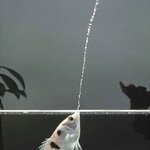Ecology & Zoology

Research published in BMC Ecology suggests that genetics may provide valuable clues as to how to crack down on the animal smuggling trade, while also helping to safely reintroduce rescued apes into the wild. The population of chimpanzees across western Africa has decreased by 75% in the past 30 years, due in part to widespread chimp hunting, and new strategies are needed to curb this illegal activity.
Researchers have been comparing genetic sequences from rescued chimpanzees with those of their wild counterparts across several areas of the country and its border with Nigeria. In doing so,…

Some animal-pollinated plants face an interesting dilemma. The same animals they rely on for pollination also like to eat them. This is the case for Nicotiana attenuata, a wild tobacco plant that grows in the American Southwest. The plant is pollinated by the night-active hawkmoth, which after the quib pro quo exchange of pollination for nectar likes to lay its eggs on N. attenuata—eggs that develop into voracious, leaf-eating caterpillars.
But N. attenuata has an interesting trick up its sleeve, say the authors of a new study in Current Biology. Stimulated by oral secretions released by the…

Not a whole lot of squid news this week, although the cephalopod mailing list continues to host a lively discussion, spurred by that coconut octopus story, of concepts like "tool use" and "intelligence". Everyone's got a different perspective! One of my favorite questions: is an archerfish that spits a jet of water to knock an insect off a branch a "tool user"? Is "using" a jet of water different from "using" a rock or a coconut shell?
Lots of questions, not a lot of answers. To muddy the waters, or maybe to add more flavors to the stew, we can consider other measures of intellectual…
New insights about the scaly-foot gastropod, a tiny snail that lives near thermal vents on the floor of the indian ocean, could help scientists design better armor for soldiers and military vehicles, according to a new study appearing in PNAS.
MIT materials scientists report that the snail's shell is unlike any other naturally occurring or man made armor. Their study suggests that its unique structure dissipates energy that would cause weaker shells to fracture.
When a crab attacks a snail, it grasps the snail's shell with its claws and squeezes it until it breaks — for days if necessary.…

Climate scientists predict increasing numbers of storms, droughts, floods and heat waves as the Earth warms, but the effects of these fluctuating conditions on biodiversity could actually go either way, according to recent ecological research. Species able to tolerate only a narrow range of temperatures, for example, may be eliminated, but instability in the environment can also prevent dominant species from squeezing out competitors.
A new Ecology Letters study of zooplankton found in dozens of freshwater lakes over decades of time has revealed both the negative and positive effects…

If you want something amusing and informative to listen to on your MP3 player, check out Parasites from the public radio show Radiolab. You can download it or listen via streaming audio.
The featured parasites include the zombie wasp, the blood fluke, and Toxoplasma. There's also a nice story about hookworm eradication in the southeast US during the early 20th century.

Hey, I'm back! I went to a rockin' party and an awesome conference and now I am full of interesting tales. Also, I am full of determination to finish my thesis this year, and an unfortunate byproduct of that resolution is a need to cut down on my blogging. Therefore, as you can see from my mutilated banner, squid-a-day is temporarily squid-a-week, until I finish my degree.
So once a week I will be delivering a concentrated dose of squid! Are you ready for the first? It's extra concentrated, since I had to cover the first twelve days of the new year . . .
We'll start with some sassy news:…

Scorpion venom is composed of a complex cocktail of poisonous peptides that immobilize animal prey on the spot. Some of the toxins in this cocktail, however, are only harmful to insects, which has prompted researchers to harness them to create a safe and ecologically sound pesticide.
Scientists from Tel Aviv University's Department of Plant Sciences have isolated the genetic sequences for important neurotoxins in the scorpion venom and have also developed methods to produce and manipulate toxins to restrict their toxicity in certain insects or mammals. The findings appear in a study published…

Scientists have long puzzled over how iguanas, a group of lizards mostly found in the Americas, came to inhabit the isolated Pacific islands of Fiji and Tonga. For years, the leading explanation has been that progenitors of the island species must have rafted there, riding across the Pacific on a mat of vegetation or floating debris. But new research in the January issue of The American Naturalist suggests that iguanas may have simply walked to Fiji and Tonga when the islands were still a part of an ancient southern supercontinent.
The two islands, located about 2000 miles east of Australia…

When people think of the Cold War they tend to dwell on all the negatives that came with it: totalitarian governments, proxy wars, a nuclear arms race, and so on. But looking back on the period, the authors of a new paper in the journal Biological Conservation say there was an odd ecological benefit that resulted from the interruption of trade that occurred between Eastern and Western Europe during the Cold war--fewer invasive species.
"Global trade is a real concern for invasive species, and the lessons we can learn from the Cold War offer a warning flag to developing countries that are now…